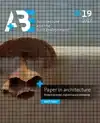- Engels
- Study
- nature & science
- technische wetensch.
- bouwkunde
- PAPER IN ARCHITECTURE
LATKA, JERZY F.
PAPER IN ARCHITECTURE
39,95incl BTW
Vertrouwd sinds 1927
Persoonlijke aandacht en advies
Vanaf 17,50 gratis verzenden NL & BE
Meer dan 150.000 artikelen online
Omschrijving PAPER IN ARCHITECTURE
Paper is a fascinating material that we encounter every day in different variants: tissues, paper towels, packaging material, wall paper or even fillers of doors. Despite radical changes in production technology, the material, which has been known to
mankind for almost two thousand years, still has a natural composition, being made up of fibres of plant origin (particularly wood fibres). Thanks to its unique properties, relatively high compression strength and bending stiffness, low production c
osts and ease of recycling, paper is becoming more and more popular in many types of industry.
Mass-produced paper products such as special paper, paperboard, corrugated cardboard, honeycomb panels, tubes and L- and U-shapes are suitable for
use as a building material in the broad sense of these words - i.e., in design and architecture. Objects for everyday use, furniture, interior design elements and partitions are just a few examples of things in which paper can be employed. Temporary
events such as festivals, exhibitions or sporting events like the Olympics require structures that only need to last for a limited period of time. When they are demolished after a few days or months, their leftovers can have a significant impact on
the local environment.
In the context of growing awareness of environmental threats and the efforts undertaken by local and international organisations and governments to counter these threats, the use of natural materials that can be recycl
ed after their lifespan is becoming increasingly widespread.
Paper and its derivatives fascinate designers and architects, who are always looking for new challenges and trying to meet the market''s demands for innovative and proecological so
lutions. Being a low-cost and readily available material, paper is suited to the production of emergency shelters for victims of natural and man-made disasters, as well as homeless persons. In order to gain a better understanding of paper''s potentia
l in terms of architecture, its material properties were researched on a micro, meso and macro level.
mankind for almost two thousand years, still has a natural composition, being made up of fibres of plant origin (particularly wood fibres). Thanks to its unique properties, relatively high compression strength and bending stiffness, low production c
osts and ease of recycling, paper is becoming more and more popular in many types of industry.
Mass-produced paper products such as special paper, paperboard, corrugated cardboard, honeycomb panels, tubes and L- and U-shapes are suitable for
use as a building material in the broad sense of these words - i.e., in design and architecture. Objects for everyday use, furniture, interior design elements and partitions are just a few examples of things in which paper can be employed. Temporary
events such as festivals, exhibitions or sporting events like the Olympics require structures that only need to last for a limited period of time. When they are demolished after a few days or months, their leftovers can have a significant impact on
the local environment.
In the context of growing awareness of environmental threats and the efforts undertaken by local and international organisations and governments to counter these threats, the use of natural materials that can be recycl
ed after their lifespan is becoming increasingly widespread.
Paper and its derivatives fascinate designers and architects, who are always looking for new challenges and trying to meet the market''s demands for innovative and proecological so
lutions. Being a low-cost and readily available material, paper is suited to the production of emergency shelters for victims of natural and man-made disasters, as well as homeless persons. In order to gain a better understanding of paper''s potentia
l in terms of architecture, its material properties were researched on a micro, meso and macro level.
Leesfragment
Specificaties
- MerkBK Books
- GroepTECHNISCHE WETENSCH (950)
- Barcode9789492516954
- LeverstatusActief
Reviews
0.0/5.0
Gemiddelde uit 0 reviews
Meest behulpzame reviews
Nog geen reviews geschreven


